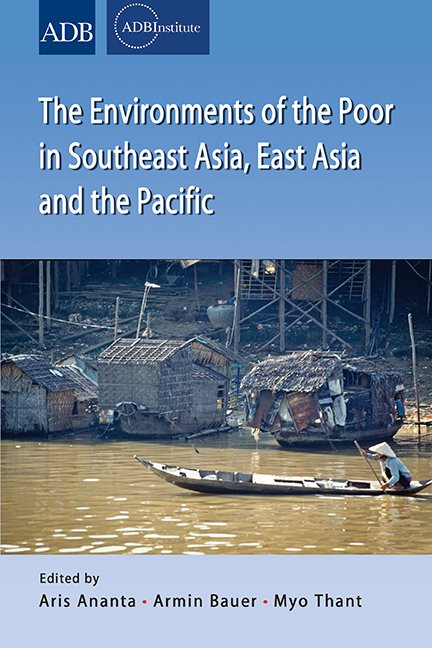Book contents
- Frontmatter
- Contents
- Preface
- List of Contributors
- Part I OVERVIEW
- Part II EAST ASIA (People's Republic of China and Republic of Korea)
- Part III PACIFIC ISLANDS
- Part IV MAINLAND SOUTHEAST ASIA (Cambodia, Thailand, Vietnam)
- Part V ARCHIPELAGIC SOUTHEAST ASIA (Indonesia, Malaysia, Philippines)
- 13 The Political Economy of Environmental Policy in Indonesia
- 14 Prospering in Environmental Degradation: An Illustration from an Upland Area, South Kalimantan, Indonesia
- 15 Making a Living in the Face of Environmental Change: A Case in an Indigenous Community in Sarawak, Malaysia
- 16 The Response of Rural Coastal Households to Typhoon Milenyo in the Philippines
- 17 Life Along Manila's Flooding Rivers
- 18 Quantifying the Health Risks from Pathogens in the Flood Water in Metro Manila
16 - The Response of Rural Coastal Households to Typhoon Milenyo in the Philippines
from Part V - ARCHIPELAGIC SOUTHEAST ASIA (Indonesia, Malaysia, Philippines)
Published online by Cambridge University Press: 21 October 2015
- Frontmatter
- Contents
- Preface
- List of Contributors
- Part I OVERVIEW
- Part II EAST ASIA (People's Republic of China and Republic of Korea)
- Part III PACIFIC ISLANDS
- Part IV MAINLAND SOUTHEAST ASIA (Cambodia, Thailand, Vietnam)
- Part V ARCHIPELAGIC SOUTHEAST ASIA (Indonesia, Malaysia, Philippines)
- 13 The Political Economy of Environmental Policy in Indonesia
- 14 Prospering in Environmental Degradation: An Illustration from an Upland Area, South Kalimantan, Indonesia
- 15 Making a Living in the Face of Environmental Change: A Case in an Indigenous Community in Sarawak, Malaysia
- 16 The Response of Rural Coastal Households to Typhoon Milenyo in the Philippines
- 17 Life Along Manila's Flooding Rivers
- 18 Quantifying the Health Risks from Pathogens in the Flood Water in Metro Manila
Summary
There has been a dramatic rise in the number of natural disasters in the world in the past decade (CRED 2009). There has been a tenfold increase in the number of climate-related events such as droughts, storms, and floods since the data were first collected in 1950. In 2009, the Philippines occupied the topmost rank in terms of disaster occurrence with 25 events, followed by China with 24, and the United States with 16 (CRED 2009). Of the 25 events, 14 were classified as meteorological (typhoon), 9 were hydrological (flood and landslide), and 2 were geophysical (volcanic eruption and earthquake). The three strong typhoons in 2009 — Kiko (Morakot), Ondoy (Ketsana), and Pepeng (Parma) — were three of the most devastating in terms of number of victims and extent of damage to property. According to the Philippine Atmospheric Geophysical and Astronomical Services Administration (PAGASA), there were, on average, 20 storms entering the Philippine Area of Responsibility every year from 1948 to 2004. Given that meteorological events occur frequently in this country, it is necessary to identify risk reduction strategies and coping mechanisms to alleviate the negative effects of a meteorological disaster.
In this chapter, I present a case study of disaster management strategies undertaken by households and local government in response to the storm Milenyo (international code name Xangsane) that hit the Philippines on 28 September 2006. According to CRED, Milenyo was the tenth most destructive disaster in the world in 2006. Evidence in this chapter comes from a dataset drawn from a household survey conducted in a village, East Laguna Village (Hayami and Kikuchi 2000), on February 2007, barely four months after the devastation by Milenyo. This study has four important findings from the experience of East Laguna Village. First, the damages caused by Milenyo varied widely from household to household even within the same village depending on the ownership of paddy fields and tree crops.
- Type
- Chapter
- Information
- Publisher: ISEAS–Yusof Ishak InstitutePrint publication year: 2013



